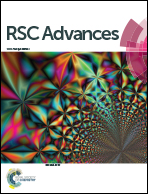Strategies for fast ion transport in electrochemical capacitor electrolytes from diffusion coefficients, ionic conductivity, viscosity, density and interaction energies based on HSAB theory†
Abstract
To elucidate factors affecting ion transport in capacitor electrolytes, five propylene carbonate (PC) electrolytes were prepared, each of which includes a salt ((C2H5)4NBF4, (C2H5)4NPF6, (C2H5)4NSO3CF3, (C2H5)3CH3NBF4 and LiBF4). In addition to conventional bulk parameters such as ionic conductivity (σ), viscosity (η) and density (ρ), self-diffusion coefficients (D) of the cation, anion and PC were measured by pulsed-gradient spin-echo (PGSE) NMR. Interaction energies (ΔE) were calculated by density function theory calculations based on Hard and Soft Acids and Bases (HSAB) theory for cation–anion (salt dissociation) and solvent–cation/anion (solvation). ΔE values are related to the salt dissociation and solvation, which affect ion diffusion radii formed by solvation and/or ion pairs. The calculated solvation ΔE values were small (around 0.30 eV) and salt dissociation energies were also small. For comparison, the ΔE value for PC–Li+ interaction was larger than that for ammonium cations, because of strong Li+ Lewis acidity. Ammonium salts are highly dissociated and each ion forms a weakly solvated structure, which is quite different from Li+ electrolytes. Weak solvation for the cation and anion in the ammonium salts are important in enhancing fast ion transfer and electrode reactions in capacitor devices.



 Please wait while we load your content...
Please wait while we load your content...